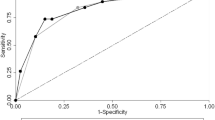Abstract
Objective
To review the incidence of significant bleeding complications after ultrasound-guided percutaneous core native renal biopsies at a single center using a standardized technique.
Materials and methods
A retrospective review of ultrasound (US)-guided percutaneous native renal core biopsies done at our institution from September 2005 to December 2015 was performed. Demographic and clinical data were collected at the time of biopsy, with additional clinical information recorded 24 h and 3 months after the biopsy. Bleeding complications were defined using the Common Terminology Criteria for Adverse Events (CTCAE, version 4.0) created by the National Institutes of Health.
Results
2204 US-guided native renal core biopsies were performed during the study period, with 37 hemorrhages (1.64%) that were CTCAE grade 3 or higher. The rate of inadequate sampling as reported by pathology was extremely low (1.1%). Factors demonstrating a significant association with bleeding risk included estimated glomerular filtration rate (eGFR), specifically when the eGFR was less than 60 (p = 0.025), platelet count (p = 0.002), including a statistically significant decreased risk of bleeding with a platelet count greater than 100 (109/L) (p = <0.001), and performing four or more needle passes (p = 0.012). While female gender was also associated with an increased bleeding risk (p = 0.05), there was a significant association between females with a BMI ≥ 25 and a decreased bleeding risk (0.034). No statistically significant association between post-biopsy hemorrhage and aspirin use within 10 days prior to biopsy or a prior diagnosis of amyloidosis was demonstrated.
Conclusion
US-guided native renal biopsy is a safe procedure with a low rate of significant bleeding complications and a high tissue adequacy rate using an 18-gage spring-loaded biopsy device. Factors associated with increased bleeding risk include female gender, lower platelet counts, decreased eGFR and performing four or more needle passes, which has not been reported previously. Interestingly, females with a BMI ≥ to 25 demonstrated a decreased bleeding risk, and aspirin (81 mg or 325 mg) within 10 days of the procedure did not demonstrate a significant effect. While not shown in this current study, the relationship of very recent aspirin therapy with bleeding is yet to be defined. Similarly, the statistically significant decreased risk of bleeding complications in overweight or obese females requires further investigation.
Similar content being viewed by others
References
Richards, N.T., et al., Knowledge of renal histology alters patient management in over 40% of cases. Nephrol Dial Transplant, 1994. 9(9): p. 1255-9.
Zhu, M.S., J.Z. Chen, and A.P. Xu, Factors that can minimize bleeding complications after renal biopsy, in Int Urol Nephrol. 2014. p. 1969-75.
McWilliams, J.P. and S.T. Kee, Native Renal Biopsy: The Perfect Storm. Journal of Vascular and Interventional Radiology, 2015. 26(2): p. 212-213.
Brachemi, S. and G. Bollée, Renal biopsy practice: What is the gold standard? World J Nephrol, 2014. 3(4): p. 287-94.
Manno, C., et al., Predictors of bleeding complications in percutaneous ultrasound-guided renal biopsy. Kidney Int, 2004. 66(4): p. 1570-7.
Corapi, K.M., et al., Bleeding complications of native kidney biopsy: a systematic review and meta-analysis. Am J Kidney Dis, 2012. 60(1): p. 62-73.
Shidham, G.B., et al., Clinical risk factors associated with bleeding after native kidney biopsy. Nephrology (Carlton), 2005. 10(3): p. 305-10.
Soares, S.M., et al., Bleeding Complications After Transcutaneous Kidney Biopsy in Patients With Systemic Amyloidosis: Single-Center Experience in 101 Patients. American Journal of Kidney Diseases, 2008. 52(6): p. 1079-1083.
US Department of Health and Human Services. National Cancer Institute. Common Terminology Criteria for Adverse Events (CTCAE) Version 4.0. US Department of Health and Human Services. National Institutes of Health. National Cancer Institute (2009).
Mai, Jun et al. Is bigger better? A retrospective analysis of native renal biopsies with 16 gauge versus 18 gauge automatic needles. Nephrology. 2013. 18(7).
Peters B, Andersson Y, Stegmayr B, et al. (2014) A study of clinical complications and risk factors in 1001 native and transplant kidney biopsies in Sweden. Acta Radiol 55:890–896
Eiro, M., T. Katoh, and T. Watanabe, Risk factors for bleeding complications in percutaneous renal biopsy. Clin Exp Nephrol, 2005. 9(1): p. 40-5.
Lees, Jennifer S et al. Risk factors for bleeding complications after nephrologist-performed native renal biopsy. Clinical kidney journal vol. 10,4 (2017): 573-577.
Slichter, S.J., Relationship between platelet count and bleeding risk in thrombocytopenic patients. Transfusion Medicine Reviews, 2004. 18(3): p. 153-167.
Stratta, P., et al., Risk management of renal biopsy: 1387 cases over 30 years in a single centre. European Journal of Clinical Investigation, 2017. 37(12): p. 954-963.
Hogan Jonathan J et al. The Native Kidney Biopsy: Update and Evidence for Best Practice. Clinical journal of the American Society of Nephrology : CJASNvol. 11,2 (2015): 354-62.
Atwell, T.D., et al., Incidence of Bleeding After 15,181 Percutaneous Biopsies and the Role of Aspirin. American Journal of Roentgenology, 2010. 194(3): p. 784-789.
Baffour, F.I., et al., Effects of Aspirin Therapy on Ultrasound–Guided Renal Allograft Biopsy Bleeding Complications. Journal of Vascular and Interventional Radiology, 2017. 28(2): p. 188-194.
Jimenez, A. H., et al. Rapidity and duration of platelet suppression by enteric-coated aspirin in healthy young men. American Journal of Cardiology 69(3): 258-262.
Yood, R.A., et al., Bleeding manifestations in 100 patients with amyloidosis. JAMA, 1983. 249(10): p. 1322-1324.
Potretzke, T.A., et al., Incidence of bleeding complications after percutaneous core needle biopsy in hypertensive patients and comparison to normotensive patients. Abdominal Radiology, 2016. 41(4): p. 637-642.
Acknowledgements
The authors acknowledge the assistance of Sonia Watson, PhD, in editing the manuscript.
Author information
Authors and Affiliations
Corresponding author
Additional information
Publisher's Note
Springer Nature remains neutral with regard to jurisdictional claims in published maps and institutional affiliations.
Rights and permissions
About this article
Cite this article
Monahan, H., Gunderson, T., Greene, E. et al. Risk factors associated with significant bleeding events after ultrasound-guided percutaneous native renal biopsies: a review of 2204 cases. Abdom Radiol 44, 2316–2322 (2019). https://doi.org/10.1007/s00261-019-01962-z
Published:
Issue Date:
DOI: https://doi.org/10.1007/s00261-019-01962-z




